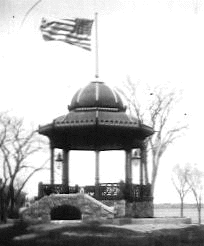
by Nancy Bertrand
The story of Wakefield’s iconic bandstand began over a decade before its construction.
The year was 1871, and the newly christened Town of Wakefield had become serious about self improvement. With its magnificent new Town Hall (a gift from Cyrus Wakefield) freshly completed, the town considered other projects. A brand new fire engine was purchased, along with a fire station to house it. Two new schools were authorized: an elementary school off Nahant Street and an “ample and elegant” new high school adjacent to the Common on Lafayette Street. And, in an unusual measure, the sum of $19,600 was expended to establish a new Park, “an extension of the Common,” in the land lying between Church Street and the Lake. The Common at that time ended at Church Street; the new expenditure would extend the parkland to the Lake.
Two years later, the midst of an economic ‘panic,’ Cyrus Wakefield died and much of the town’s public-spirited vitality seemed to die with him. For years, little was done to improve the new park. But in 1881, an unusual bequest was received from Cornelius Sweetser.
Sweetser had been born and raised in South Reading , but made his fortune as a shoe manufacturer in Maine. He left his native town the sum of $10,000 to be used to beautify a public park in a bequest that was conditional upon the town’s matching these funds for the same purpose. In 1883, the town accepted the bequest, allocating $10,000 in matching funds for beautification.
The bequest coincided with a new Massachusetts municipal law authorizing towns to lay out public parks within their limits. Wakefield appointed a Board of Park Commissioners to oversee the project, and the work began in earnest. Fences were built, the ‘old Common’ was drained and groomed, and concrete walks were laid out. The ‘new Park’ was filled and graded, and two additional lakeside lots were purchased to extend the public land. Granite curbing was purchased, along with a water fountain. And, in 1885, the Bandstand was built for the sum of $2500.
In constructing the Bandstand, Wakefield was following a national trend. Small town brass bands had become very popular after the Civil War, and, with the growth of the middle class in Victorian America, there was a demand for leisure activities that were both healthy and cultural. Bandstands and music pavilions, serving as a combination of public sculpture and common assembly places, were being constructed in cities and towns from coast to coast.
The construction of Wakefield’s new “Music Pavilion,” however, did not proceed without some controversy. A newspaper story remarked that the “Pagoda” had a “dome-like top” painted red, “the color of the heart’s blood of the indulgent tax-payer,” although it “would doubtless be a very handsome structure… a very worthy ornament to the Park.”
The newspaper columnist was prophetic, but Wakefield’s Bandstand has become more than a mere ornament. With its signature location overlooking Lake Quannapowitt, it has become a symbol of the town of Wakefield and many of its community groups, all working for the betterment of their town.


Very interesting information. Thank you! What can you tell me about a structure near the bandstand called “The Yale Engine House?”
LikeLike
The original Yale Engine house was wooden, and built in 1852. Ironically, it burned down in 1859. It was replaced the same year by the brick faced engine house. The engine house stood near the bandstand from 1885 to 1891, but was taken down that year. Bricks from the Yale Engine House were used in the foundation of theCentral Fire station (which was actually a recycled school building) in 1891. Ironically the Central Fire Station itself would burn down during the Hathaway stable fire in 1899. Kind of a confusing history! I’ll see if I can upload a picture of the Yale Engine House tomorrow.
LikeLike